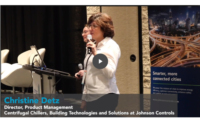Every successful project starts with a framework. A vision statement. A blueprint.The editors of Engineered Systems are proud to present The Blueprint — a monthly Q&A interview with HVACR engineering’s leading voices. These one-on-one discussions will examine the trade’s history, current industry trends, the factors shaping the sector’s future, and more.
Johnson Controls believes every building serves a purpose. That’s why the company has been dedicated to making buildings smarter since 1885, and its capabilities, depth of innovation, experience, and global reach have been growing ever since. Today, the Milwaukee-based manufacturer, which employs 105,000-plus employees across 2,000 global locations and boasts more than $23 billion in sales, offers one of the world’s largest portfolios of building products, technologies, software, and services.
Recently, Mark Lessans, director of regulatory and environmental affairs, Johnson Controls, sat down with Engineered Systems editor-in-chief, Herb Woerpel, to discuss the rising role of decarbonization, introduce us to the OpenBlue Healthy Buildings solution, and more.
Engineered Systems: Mark, please take a moment to introduce yourself.
Mark Lessans: I’m Mark Lessans, director of regulatory and environmental affairs at Johnson Controls. I’ve spent the past 12 years working on building energy efficiency and decarbonization policies with roles in the public, private, and NGO sectors.
Engineered Systems: Decarbonization is a major trend in the HVACR industry. Why is this so, and why is it so important that the industry gets this right?
Lessans: Decarbonization is not just a major trend in the HVACR industry, it is the major trend. Buildings are responsible for roughly 40% of greenhouse gas emissions globally, and HVAC equipment is easily responsible for half of those emissions. Addressing climate change in earnest requires putting buildings on a pathway to net zero, which cannot be achieved without deep decarbonization of HVAC end uses. It’s through this lens that I view future innovations in HVAC equipment and operation, and, frankly, decarbonization is what will keep the industry relevant.
What makes this trend so exciting is thinking about how the HVAC industry fits into the broader decarbonization picture. There are so many different technology applications in this space that the optimal solution will change from building to building. And it’s not just about the building. There’s an interplay with the grid — modifying loads to source the lowest-carbon energy possible and contributing to grid reliability — that impacts overall emissions. Decarbonization is a giant engineering systems problem in which buildings, their HVAC systems, and the grid have an important role to play.
There’s no question in my mind that we are moving toward a near-zero emissions economy. If the HVAC industry focuses on solutions to decarbonize building operations, it has a chance to write its own future.
Engineered Systems: In what ways is Johnson Controls embracing decarbonization?
Lessans: When you look across the Johnson Controls portfolio of building technologies, from HVAC equipment and systems to sensors, controls, building automation systems, and digital connectivity platforms like OpenBlue, we are second to none in our ability to deliver a comprehensive net-zero building. So, we are really leaning into our role as a solutions provider for building decarbonization.
The trend in building decarbonization is at an inflection point, and internally we have been working through all of the anticipated technology capabilities that will be needed today and in the future to ensure we have as many applications covered as possible. We’re also looking at new ways to go to market with decarbonization solutions by leveraging the guaranteed performance, as-a-service models we have already mastered for energy efficiency.
Engineered Systems: Care to elaborate on any of those technologies?
Lessans: Yes, let’s take heat pumps for example, which are a critical technology for decarbonizing space heating. Between our York®, Sabroe, and Frick brands, plus our joint Johnson Controls-Hitachi venture, we have arguably the most comprehensive portfolio of heat pump applications on the planet. But, there are so many different applications for heat pumps that the optimal solution will vary building by building and region by region. This fundamental issue needs to be understood as we pursue building decarbonization policies to ensure that all of these technology options are at our disposal. And to that end, Johnson Controls is consistently reviewing its heat pump portfolio to understand where our strengths are and where we need to improve. Efficient operation in cold climates is of particular importance.
Engineered Systems: The company has set some fairly ambitious goals through its environmental sustainability commitments, including a notion to reduce operational emissions by 55% and reduce customers' emissions by 16% before 2030. Tell us a little more about this goal.
Lessans: Earlier this year we committed to science based targets, which represent the share of Johnson Controls’ emissions reductions needed to keep global temperature rise at or below 1.5°C. Those targets include a 55% absolute reduction in the emissions attributable to our own operations, and a 16% absolute reduction in the emissions attributable to the use of our products by our customers. It’s the latter part of that commitment that I am personally most excited about because it puts a priority on Johnson Controls’ comprehensive suite of solutions across operating and information technologies that enable steep reductions in carbon emissions. At Johnson Controls, we are integrating these considerations into new product development and positioning to lead the market in a carbon-constrained world.
In addition to our science based targets, we also committed to achieve net-zero emissions from our operations by 2040, dedicate some 75% of R&D spending in new product development to support sustainability, and ensure accountability by tying achievement of our sustainability goals to executive compensation.
Engineered Systems: Introduce us to the OpenBlue Healthy Buildings solution and explain how it’s designed to create healthy people, healthy places, and a healthy planet.
Lessans: OpenBlue is a suite of connected technologies that integrates building systems like automation, controls, HVAC, security, and more to create a unified, smart building environment. OpenBlue enables all building systems to work together intelligently and proactively to react to conditions and events that would normally require operator intervention.
OpenBlue Healthy Buildings is our digital solution for keeping people healthy and safe in the places they inhabit. By connecting and integrating building assets, it benchmarks people-focused outcomes, such as key performance indicators for indoor air quality, or contact tracing among occupants. The platform allows building managers to set parameters and adjust systems and operations to maintain building performance.
Our OpenBlue ecosystem is a great example of how one performance outcome, such as IAQ, does not have to be traded off against another, such as energy efficiency or decarbonization. OpenBlue helps our customers utilize predictive analytics to determine current and future operational needs and provides actionable insights to optimize building loads and maintain building performance.
Engineered Systems: What one technology or approach will have the biggest impact on the built environment in the next 10 years that isn’t getting much attention today?
Lessans: Enablers of grid-interactive efficient buildings, or GEBs, is where this industry is headed directionally and is one of the keys to unlocking building decarbonization at scale. To revisit the mega-trend, we’re seeing the replacement of fossil fuel electricity with renewables that have variable generation profiles, the grid shifting from centralized to distributed, and the electrification of transportation and building end uses. This is the “engineering systems” problem I alluded to earlier: The grid as we know it is going to transform as it decarbonizes. In buildings, we’ll see tremendous value in building system/sub-system controls that can optimize loads as well as on-site generation and storage assets like batteries. And that’s where GEBs will come in: We’ll need a standardized approach to ensuring buildings can communicate with and respond to signals from the grid in order to maintain reliability and reduce the emissions intensity of the energy we consume while simultaneously ensuring that they remain functional and respond to occupant needs.
The U.S. Department of Energy has been leading the charge in defining GEBs and recently released a roadmap for their market penetration. It’s a transition that we’ll see over the next 10 years and will impact the way building systems, including HVAC, will be designed, specified, and operated.
Engineered Systems: If readers are interested in learning more about Johnson Controls’ decarbonization efforts, where should they turn?
Lessans: You can learn more about our vision for healthy people, healthy places, and a healthy planet at johnsoncontrols.com and connect with us on Facebook, Twitter, and LinkedIn.





